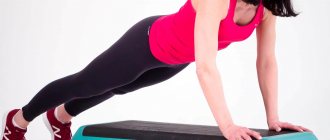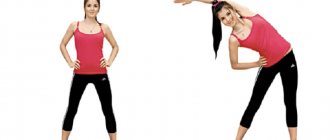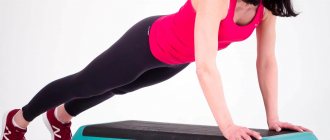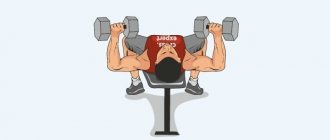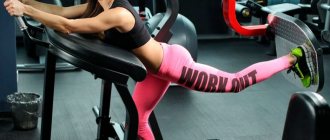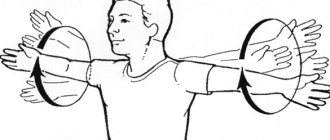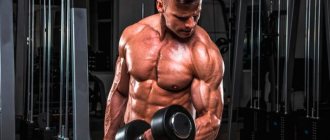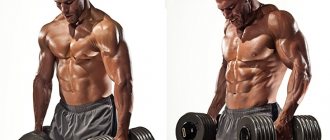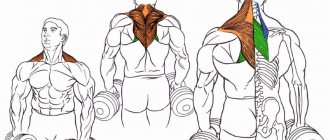The deltoid muscles consist of anterior, middle and posterior bundles. They participate in all pressing movements. Raising your arms forward, pressing away and up - this is their main function. The anterior deltoid works when we open a door, move our arm in front of us, or try to shake a barbell in the gym. This muscle is not large, but its development is important not only for aesthetics, but also for preventing injuries. Front raises are a great isolation exercise for the anterior deltoid.
Working muscles
The main mover in lifting dumbbells or a barbell in front of you is the anterior bundle of the deltoid muscle of the shoulder. Stabilization of movement occurs due to the inclusion of the middle deltoid bundle. If the athlete spreads the dumbbells slightly to the sides during the movement, it is possible to additionally engage the rear deltoid. But such a technique in fitness is not desirable, since it transfers the load from the target muscle.
The quadriceps, hamstrings, buttocks, abs, and calf muscles are used as stabilizers. Heavy dumbbells are quite difficult to lift while keeping your body upright. Therefore, the athlete should fix the starting position due to the static tension of the listed muscles.
Important: arm and shoulder training cannot consist only of swings. For harmonious development, you need to do dumbbell presses, train your pectorals, triceps, and back. This movement is performed as an isolating movement, one of the exercises in the training plan.
Useful tips
To increase the effectiveness of the exercise, you can turn your hands with your palms facing inward. Using this position, the load from the external part of the deltas will be transferred to the internal part, which is rarely involved in the work. Another way to increase the effectiveness of the exercise is to turn your hands with your palms up at the top point of the amplitude. Then the load will be concentrated even more on the inner part of the deltas.
Do not forget that the elbow joints must be bent . In this case, the dumbbells should rise to the same level as the shoulders, but for better development they can be raised higher.
Weightlifters, working with heavy weights, help themselves a little with their bodies. However, this method of training is not suitable for beginners with weak muscles, since they need to tone them first and then experiment with heavier dumbbells.
You can always view the fractional meals menu for the week on our website.
The donkey exercise helps develop the calf muscles. Read about it in detail here: /silovye/s-nogi/golen/osel.html.
Weight selection and warm-up exercises
This movement is recommended for beginners to start with 2-5 kg. At the same time, a couple of kilos are recommended for girls, and 5 for men. In fact, this is not how weight is chosen at all. You need to take the lightest dumbbells that are available and perform a set of the exercise with your back pressed against any support. If you managed to do 10-12 repetitions without any problems, and you have the strength to continue, you should add another kilogram. They move like this until they reach a weight that can be lifted for 10-12 repetitions enough to feel a burning sensation in the front delts.
Warm-up approaches are taken 4-5 kg less than the main one, then the weight is gradually added. It must be kept in mind that the exercise is performed at the end of a standing or bench press workout, so the athlete is already warmed up. But this is not a reason to skip the warm-up approach, since only it guarantees the safety of the main work and allows you to completely avoid injury.
Important: general warm-up and joint warm-up should precede any chest or shoulder workout. Athletes often neglect this because they think that it is easier to train the shoulders than the legs, and therefore they can warm up while working. It is better not to skip rotations in the shoulder joints and rehabilitation exercises, otherwise the training may end in injury.
That's DUMBELL SWINGS IN FRONT OF YOURSELF, baby!
Technical points
Raising dumbbells in front of you, despite its apparent simplicity, is a technically complex athletic movement. When performing it, you need to pay attention to many details and follow a wide range of recommendations. Depending on the grip and quantity involved in the exercise of the upper limbs, the following types of swing movements with dumbbells on the anterior delta are distinguished.
Dumbbell grip
There are 3 main types of grip that are widely used:
Movement amplitude
Depending on the amplitude of movement, there are 3 main types of lifting dumbbells in front of you:
| Full amplitude. | Starting position – arms straight and down. To perform full amplitude swings, use a straight closed grip. The movement continues until the arms reach the top point above the head. In this case, the amplitude is about 180°. |
| Partial or half amplitude. | The dumbbells are lifted until the bunches reach a line parallel to the floor. In this case, both a straight and a hammer grip can be used. |
| Half amplitude with a shift to the midline of the body. | To perform this version of the exercise, only a reverse grip is used. Your elbows should be bent and your thumbs should tightly grip the back of the dumbbell bar, forming a lock. When moving upward, the hands are shifted to the center. At the top point their mutual contact occurs. |
Execution technique
The most important thing is to take a starting position in which the body will be stable and it will be possible to avoid swinging. In regular fitness, it is not recommended to do this movement with cheating, since throwing the weight above the shoulder line can lead to injury.
You should stand up straight, contract your abdominal muscles, slightly bring your lower ribs towards your pelvis, place your feet firmly on the floor, and tighten your quadriceps and buttocks. Dumbbells are grabbed either with an overhand grip or a palms-up grip. The movement goes like this:
- Lifting the weight due to the force of the front deltas to shoulder level;
- Lowering while exhaling without “dumping” the weight;
- The dumbbells along the entire trajectory are at the same distance from each other. There is no need to “spread” them too far to the sides so that the middle deltoids are included in the work;
- Lifting with dumbbell rotation around the axis of the bar is allowed only for variety of training and with light weight;
- Beginners can lift dumbbells one at a time if there is no stability and it is impossible not to include the legs when lifting the weight;
- If you can’t keep the trajectory relatively the same on the right and left, you should perform a similar exercise - standing up with a barbell
The pace of execution should not be high, it is enough to work on average, only 11-15 repetitions. This exercise is not suitable for testing strength; moderate weights and tempo are needed.
Swing dumbbells in front of you
+3
Dumbbell shoulder swings are isolated work that is traditionally used for selective deltoids training. As you all, I hope, remember, all exercises in bodybuilding are divided into two main types. This:
- BASIC.
Where two or more joints work. - INSULATING
. Only one joint works here.
Isolated exercises for broad shoulders.
There is still a lot of controversy about the effectiveness of certain types of movements. Someone says that “only the base” and everything else is bullshit. And someone cites as an argument the fact that in isolated exercises only what we need works (other muscles do not “steal” the load).
Bodybuilding has been practiced for more than a century, and during this time athletes have tried a huge number of different techniques and methods. If one kind of movement really was better than another, then everyone would have been doing the “correct” movements a long time ago. However, in practice, we see both compound and isolation movements being used by athletes at all levels. However, there is one imperial observation... BEGINNERS BETTER WORK IN THE BASIC EXERCISES!
The main problem with isolated exercises is that they perfectly focus the load ONLY if the athlete maintains ideal technique or has good feeling and contraction of the working muscle. It is a rarity. This only comes with time due to endless repetitions of exercises. A beginner who has not learned to really feel his muscles, the type and pace of movement, takes dumbbells and begins to do swings that work not the deltoids (the target muscle group), but the core, calves and trapezius. A beginner often simply does not understand what the essence of the movement is. That it is necessary not to simplify the movement by swinging, but to make it as difficult as possible. In order to understand such simple things, a beginner must become an experienced athlete. And this is exactly how an experienced person differs from a beginner. And not at all the size of his muscles, which can change enormously throughout the year.
Swings and presses for shoulder training.
There are two main types of shoulder training exercises. This:
- PRESSES (BASIC EXERCISES)
= two joints (shoulder and elbow) - SWINGS (ISOLATED EXERCISES)
= one joint (shoulder)
In the first case, as you guessed, more muscles work (because there are more joints), and in the second there are fewer muscles. However, if we talk about our deltoids, then not everything is so simple and unambiguous due to the complex structure of these muscles.
Usually our muscles perform one, main function. For example, the biceps and back pull weight toward the body (pulling muscles), while the chest, triceps, or quadriceps push weight away from the body (pushing muscles). If you think about your deltoids, you will understand that with their help we can do both pulling (swing) movements and pushing (pressing) movements. This is very rare for our body and our deltoids, in this regard, are exceptional muscles. The price for this exceptional mobility is exceptional tenderness. Our shoulder joints are the most easily injured under any heavy load.
What muscles work in front swings?
This exercise targets the anterior (front) part. Bent over or lateral swings usually target the back and midsection. That makes all the difference. BUT all swings are isolated exercises and therefore they must be performed technically correctly in order not to injure the shoulder joint...
Traditionally, the delta is represented from three bundles: FRONT
(presses and raises in front of you)
MIDDLE
(and presses and swings to the sides)
REAR
(bent over swings)
As you can see, the middle beam is intermediate because it performs a hybrid load. From this point of view, I divide the delta into only TWO PARTS (the front half, which pushes and lifts in front of us, and the back half, with which we swing through the sides and in an incline).
Front swings are an isolated exercise for the front half of our delta. This is the part that is located frontally and which usually does not need much training. The fact is that the front delta actively works in any pressing exercises, such as bench or standing barbell presses.
What types of swings in front of you exist?
There are a lot of modifications. We will not consider options on blocks. Let’s limit ourselves to the basic options with free weights performed while standing, as more basic movements:
ALTERNATING WITH DUMBBELLS.
The most popular option. You need to take two dumbbells with a regular (straight) grip. After this, raise your straightened right arm so that it becomes perpendicular to your body. Microsecond delay and smooth return to the starting point. After this, we repeat the same for the left hand. Then right again. Then left...etc. and so on.
WITH A BAR.
The difference is that you simultaneously raise two hands in front of you, which squeeze the barbell. It's harder to do that. However, you save a lot of your time because both arms are raised at the same time.
WITH ONE DUMBBELL.
Just like with a barbell, it uses two hands at once (this saves time). But instead of a barbell, you hold the dumbbell by one end with a comfortable grip.
Rotation of the shoulder joint during swings.
You may have heard the typical recommendation to “pour the water out of the cup” during the swing. Those. turn your thumb down (and your little finger up) as you lift the dumbbells up. It's a good idea to train the mid-rear part of your delts because this trick eliminates your biceps from working (isolating the delts). However, you shouldn’t do this with the front deltoid because it is not the middle-rear part.
When lifting in front of you, you do not need to rotate your shoulder joint. You will only weaken your deltoids and put the joint at risk of injury. On the contrary, when lifting the dumbbell in front of you, make sure that at the top point the bar of the dumbbell is parallel to your spine. There is no need to unfold the dumbbells in one line.
The place of swings in a set of shoulder exercises.
Swings are needed in two main situations: WARM-UP
before heavy work in bench presses or deltoids.
SUPPLEMENT after
heavy work in bench presses or deltoids.
There is one EXCEPTION regarding the order of the exercises. If your rear deltoids are lagging behind, then it is permissible to start your shoulder training with bent over swings to eliminate the lag.
HOW MANY REPEATS?
Delta loves high reps for a number of reasons.
First of all, your shoulder joint is used to working all day. And besides, light weights and short amplitudes require us to do more repetitions to compensate. REPS = 10-15 SET = 4
Contraindications
It is believed that there are only two of them:
- Abdominal surgery (rehabilitation takes six months);
- Shoulder injuries
In fact, there are more of them. There is no need to perform swings and lifts in case of spasms of the trapezius muscle, exacerbation of pain due to osteochondrosis or arthrosis. It also makes sense to eliminate assistance exercises if an athlete is having trouble recovering from heavy lifts.
This movement does not need to be included in the plan “instead of” dumbbell and barbell shoulder presses if the goal is to completely unload the joint. If there are problems with recovery, it makes sense for the athlete to choose complete rest for several days, or pressing movements with light rubber, but not swings with weights.
DUMBBELL SWINGS IN FRONT OF YOU
Additional recommendations
For anyone starting to train with dumbbells, it is recommended to implement a monitoring system to see progress:
- write down the exercises in your training diary, how many times they were performed and the weight of the dumbbells used;
- measure and record body girth in a table once a week, preferably in the morning on an empty stomach;
- It is optimal to weigh yourself once every two weeks and record the results;
- Take photos every month, with the same poses and lighting every time.
For full-fledged training, it is better to purchase collapsible equipment. Exercises using dumbbells for losing weight and pumping up muscles will have to be performed with different weights for each muscle group. In addition, the mass will need to be gradually increased.
Beginners or those who have had a long break should not lift dumbbells over 7 kg. To understand your weight, you need to do one exercise 20 times and evaluate whether it is too light or, conversely, whether you feel strained. Only muscle tension should be felt. Typically, exercises are repeated 12 times in 3 approaches.
The main thing before starting training is to set a goal. This could be getting rid of the belly and sides for men, gaining strength or mass, or creating a neat relief. Exercises with dumbbells will help you create a beautiful body at home or in the gym.
